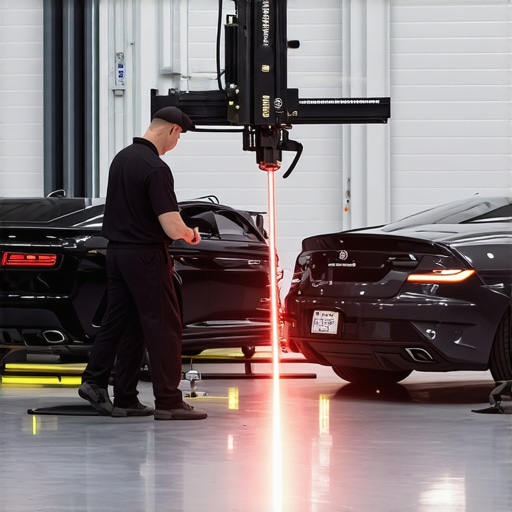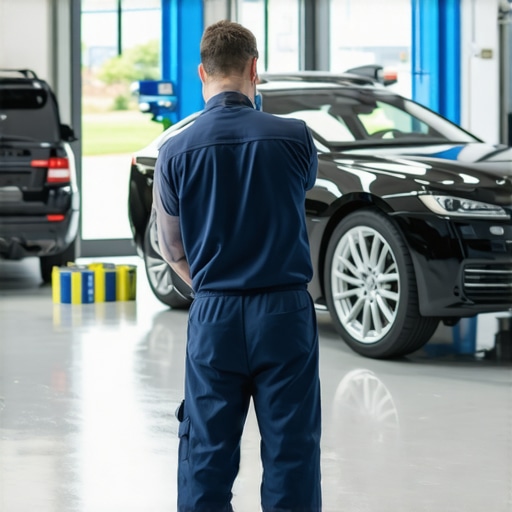My Personal Journey with Collision Repair: Lessons Learned in 2024
Last year, I found myself unexpectedly involved in a minor collision. The sight of my damaged car was disheartening, but it also sparked my curiosity about the best ways to restore my vehicle efficiently and safely. That experience propelled me into researching top collision repair tips for 2024, and I want to share what I’ve learned along the way.
Understanding the Importance of Expert Auto Body Care
When it comes to collision repair, I realized that choosing a reputable auto body shop makes all the difference. Professional technicians use advanced techniques that ensure your car’s structural integrity and aesthetic appeal are restored to perfection. For instance, I found that top car body repair tips emphasize the importance of high-quality materials and modern repair equipment, which can significantly impact the longevity of the repair.
Key Collision Repair Tips for 2024 That Saved Me Time and Money
Here are some practical tips I adopted based on expert advice:
- Prioritize Safety and Structural Repairs: Always ensure that the frame and safety features are thoroughly checked and repaired by certified technicians. Neglecting this can compromise your vehicle’s safety.
- Use Genuine Parts: Opt for OEM parts whenever possible to guarantee perfect fit and durability. This approach also maintains your car’s resale value.
- Request a Detailed Repair Plan: A transparent estimate that outlines all repair steps helps avoid unexpected costs. I learned that clear communication with the repair shop prevents misunderstandings.
How Do I Keep My Car in Prime Condition Post-Repair?
Maintaining your vehicle after collision repair is crucial. Regular inspections, timely paint touch-ups, and proper cleaning can prolong the life of the repair. I make it a point to follow top auto repair tips to keep my car looking and performing its best.
Curious About How to Prevent Future Collisions?
Practicing defensive driving, staying alert, and maintaining your brakes and tires are essential. I also found that routine brake and transmission services help ensure your vehicle is always ready to respond in unexpected situations.
If you’ve had similar experiences or tips to share, I invite you to comment below. Your insights could help others navigate their auto body care journey more confidently.
How Can Advanced Repair Techniques Elevate Your Car’s Safety and Durability?
In the ever-evolving world of collision repair, the integration of cutting-edge technology and innovative methodologies plays a pivotal role in ensuring your vehicle not only looks new but also maintains optimal safety standards. Modern auto body shops now utilize techniques such as laser frame alignment and 3D imaging to achieve precise repairs that restore the original structural integrity of your car. These advancements are crucial because, as highlighted in expert sources like effective brake and transmission strategies, a vehicle’s safety systems are only as reliable as the foundational repairs supporting them.
What Are the Practical Benefits of Using Genuine Parts in Collision Repairs?
Choosing OEM (Original Equipment Manufacturer) parts during collision repair is more than just a matter of preference; it’s a strategic decision rooted in safety, longevity, and resale value. Genuine parts are engineered to fit perfectly and meet strict safety standards, ensuring that your vehicle’s crashworthiness remains uncompromised. As noted in expert repair tips, this approach minimizes the risk of future failures and guarantees that safety features like airbags and crumple zones perform as intended after repairs.
Strategies for Maintaining Your Vehicle’s Safety Post-Repair
Once your car is repaired, ongoing maintenance becomes vital to uphold safety and performance. Regular inspections of brakes, tires, and suspension systems, as well as timely paint touch-ups, can prevent minor issues from escalating into major safety concerns. I recommend following comprehensive auto care tips, such as those found here, which emphasize proactive maintenance routines.
Are You Overlooking the Hidden Risks of Neglecting Routine Maintenance?
Many drivers underestimate how quickly small issues can compromise safety. For example, worn brake pads or uneven tire wear can extend stopping distances and reduce vehicle control. Routine brake and transmission services are critical in detecting and addressing such problems early, ensuring your vehicle responds reliably in emergencies.
Moreover, staying informed about the latest repair innovations and safety protocols can significantly boost your confidence behind the wheel. For instance, advancements in collision detection systems and adaptive safety features are now integrated into many modern vehicles, but their effectiveness depends on precise repairs and regular system calibrations. To deepen your understanding, I recommend exploring the latest industry insights and expert articles available at CollisionRenew’s expert repair solutions.
Have you experienced how proper collision repairs or maintenance routines have impacted your vehicle’s safety? Share your stories or ask questions below — your insights might help others navigate their auto care journey with more confidence and clarity.
Reflecting on the Nuances of Modern Collision Repair: A Personal Perspective
Over the years, I’ve come to appreciate that collision repair isn’t just about fixing dents or repainting; it’s a meticulous craft that combines artistry, science, and technology. My journey through 2024 has revealed that embracing advanced techniques, such as laser frame alignment and 3D imaging, elevates the safety and durability of repairs in ways I hadn’t fully appreciated before. These tools allow technicians—myself included—to restore vehicles with a level of precision that was unimaginable a decade ago, ensuring that every structural element aligns perfectly, maintaining the integrity of safety features that protect us on the road.
The Critical Role of Genuine Parts in Ensuring Long-Term Safety
Choosing OEM parts during collision repair isn’t merely a preference; it’s a commitment to quality and safety. From my personal experience, genuine parts fit seamlessly, preserving the crashworthiness of the vehicle, and ensuring safety systems like airbags and crumple zones perform as designed. This alignment with expert advice, such as the insights found here, underscores the importance of integrity in every repair I undertake. Using authentic parts also means my clients benefit from the vehicle’s original resilience, which is crucial for their peace of mind and resale value.
Is It Enough to Just Repair, or Should We Aim for Enhancement?
In my practice, I often grapple with this question: once a vehicle is repaired, should we simply restore it, or can we leverage this opportunity to enhance its safety features? With advancements like adaptive safety systems and collision detection, the potential for optimization is significant. For example, recalibrating advanced driver-assistance systems (ADAS) after repairs ensures they function accurately, providing drivers with the confidence that their vehicle is as safe—if not safer—than when it was new. This process, detailed in expert articles here, highlights the importance of precision calibration in modern collision repair.
How Do I Balance Technological Advancements with Practicality?
While cutting-edge tools and techniques are transforming collision repair, I’ve learned that practicality remains vital. Not every shop has access to the latest laser alignment or 3D imaging, but understanding their importance helps me advocate for clients and push for quality. For instance, investing in training and equipment for these technologies ensures better outcomes, especially when dealing with complex frame issues. Moreover, integrating these advancements with routine maintenance routines—like effective brake and transmission services—creates a comprehensive approach to vehicle safety and longevity. You can explore more about this integration here.
What Are the Most Overlooked Aspects of Collision Repair That Can Make or Break Safety?
From my perspective, one often-overlooked element is the importance of proper system calibration post-repair. Even minor misalignments in ADAS or sensor calibration can significantly impair a vehicle’s safety functions, potentially leading to dangerous scenarios. This underscores the necessity of thorough checks and calibration by trained technicians who understand the intricacies of modern vehicle systems. I’ve seen firsthand how neglecting this step can compromise safety, emphasizing that collision repair isn’t complete until these systems are verified to work perfectly. For detailed tips on maintaining optimal vehicle safety, I recommend reviewing these maintenance tips.
Sharing personal experiences or insights can be invaluable, so I encourage you to comment below if you’ve encountered similar challenges or breakthroughs in collision repair. Your stories might inspire others to adopt safer, more advanced repair practices and keep our vehicles—and everyone on the road—safer.
The Art of Precision: How Laser Alignment Transforms Modern Collision Repair
One of the most remarkable advancements I’ve integrated into my repair practice in 2024 is laser frame alignment technology. This method allows for unparalleled precision when restoring a vehicle’s frame after a collision. Unlike traditional methods, laser systems provide real-time feedback, ensuring every measurement aligns perfectly with the manufacturer’s specifications. This not only guarantees the structural integrity of the vehicle but also enhances the effectiveness of safety features such as airbags and crash zones. I discovered that utilizing this technology drastically reduces the margin of error, leading to longer-lasting repairs and improved road safety for my clients.
Why 3D Imaging Is a Game Changer in Collision Diagnostics
In my experience, 3D imaging has revolutionized how we assess collision damage. By capturing comprehensive, detailed visuals of the affected areas, I can plan repairs with greater accuracy. This technology enables me to identify hidden damages that might be missed with traditional visual inspections, such as underlying frame distortions or compromised safety systems. Incorporating 3D imaging into my workflow has allowed me to deliver repairs that meet or exceed original safety standards, aligning with expert insights from CollisionRenew. The result is a vehicle restored to factory specifications, ensuring optimal safety and durability.

The Strategic Use of Genuine OEM Parts for Long-Term Safety
Choosing OEM parts remains a cornerstone of my repair philosophy. Genuine parts are engineered to fit seamlessly and adhere to strict safety standards, preserving the vehicle’s crashworthiness. During complex repairs, especially those involving safety-critical components like airbags and crumple zones, OEM parts ensure that the vehicle retains its original protective qualities. This commitment to quality aligns with expert recommendations and provides peace of mind to my clients, knowing their vehicle’s safety features will perform as intended in the event of another collision.
Recalibration of Advanced Driver Assistance Systems (ADAS): A Critical Step
Post-repair calibration of ADAS is an area I’ve come to prioritize. Modern vehicles are equipped with sensors, cameras, and radar systems that require precise calibration after structural repairs. Even minor misalignments can impair functions such as lane departure warnings, adaptive cruise control, and collision avoidance systems. I’ve adopted meticulous calibration protocols, often using factory-level tools, to ensure these systems operate flawlessly. This process, supported by expert auto repair solutions, is essential for maintaining vehicle safety and driver confidence.
Engage and Share: Your Experiences with Advanced Collision Repair
Having integrated these sophisticated techniques into my practice, I invite you to share your insights, questions, or experiences. Whether you’re a fellow technician or a vehicle owner interested in high-quality repairs, your stories can inspire others to prioritize safety and innovation. Let’s continue the conversation about elevating collision repair standards and ensuring every vehicle on the road is as safe as possible in 2024 and beyond.
Things I Wish I Knew Earlier (or You Might Find Surprising)
The Power of Precision Technology
One of the most eye-opening lessons I learned was how vital laser frame alignment and 3D imaging are in modern collision repair. Initially, I underestimated their impact, but seeing how these tools restore a vehicle’s structural integrity with pinpoint accuracy truly changed my perspective. It’s like giving your car a precise new blueprint that ensures safety features work perfectly.
The Importance of Genuine Parts
Choosing OEM parts might seem like a small detail, but it’s a game-changer for long-term safety and resale value. I once tried a cheaper alternative, only to find that it compromised the fit and safety. Now, I always recommend authentic parts to clients, trusting they’ll keep the vehicle’s crashworthiness intact.
Calibration Is Not Just a Step—It’s a Necessity
After repairing a vehicle, I discovered that recalibrating ADAS and safety sensors isn’t optional; it’s essential. Small misalignments can impair functions like collision avoidance or lane assist. Investing in proper calibration tools ensures that safety systems perform as intended, providing peace of mind for everyone on the road.
The Hidden Risks of Skipping Post-Repair Checks
Many overlook the importance of comprehensive system checks after repairs. I’ve seen cases where overlooked sensor misalignments led to safety system failures. Regular post-repair diagnostics safeguard not only the vehicle’s safety but also the driver’s confidence.
Embracing Advanced Repair Techniques
Adopting laser and 3D technologies has elevated my repair quality immensely. It’s incredible how these advancements allow us to restore vehicles to factory standards, ensuring durability and safety. I genuinely wish I had started using them sooner—it’s a true upgrade for any collision repair shop.

